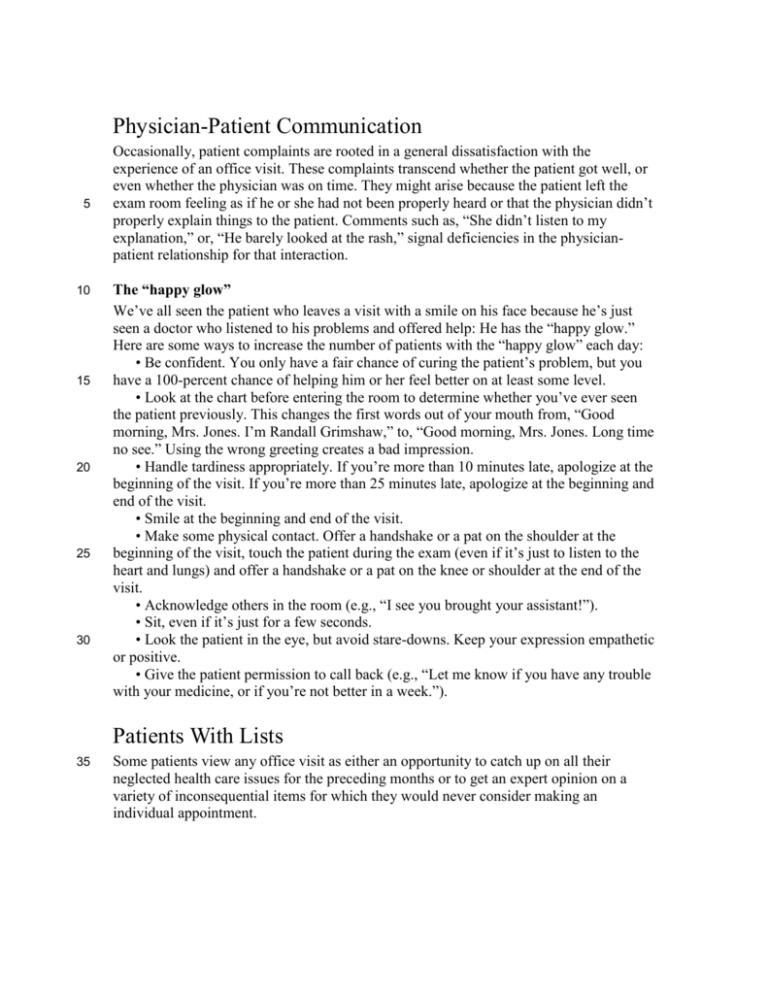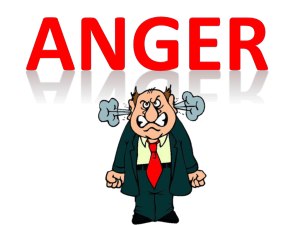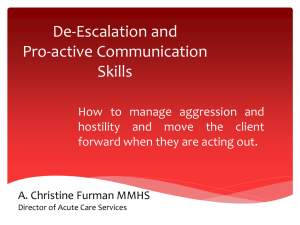
Physician-Patient Communication
5
10
15
20
25
30
Occasionally, patient complaints are rooted in a general dissatisfaction with the
experience of an office visit. These complaints transcend whether the patient got well, or
even whether the physician was on time. They might arise because the patient left the
exam room feeling as if he or she had not been properly heard or that the physician didn’t
properly explain things to the patient. Comments such as, “She didn’t listen to my
explanation,” or, “He barely looked at the rash,” signal deficiencies in the physicianpatient relationship for that interaction.
The “happy glow”
We’ve all seen the patient who leaves a visit with a smile on his face because he’s just
seen a doctor who listened to his problems and offered help: He has the “happy glow.”
Here are some ways to increase the number of patients with the “happy glow” each day:
• Be confident. You only have a fair chance of curing the patient’s problem, but you
have a 100-percent chance of helping him or her feel better on at least some level.
• Look at the chart before entering the room to determine whether you’ve ever seen
the patient previously. This changes the first words out of your mouth from, “Good
morning, Mrs. Jones. I’m Randall Grimshaw,” to, “Good morning, Mrs. Jones. Long time
no see.” Using the wrong greeting creates a bad impression.
• Handle tardiness appropriately. If you’re more than 10 minutes late, apologize at the
beginning of the visit. If you’re more than 25 minutes late, apologize at the beginning and
end of the visit.
• Smile at the beginning and end of the visit.
• Make some physical contact. Offer a handshake or a pat on the shoulder at the
beginning of the visit, touch the patient during the exam (even if it’s just to listen to the
heart and lungs) and offer a handshake or a pat on the knee or shoulder at the end of the
visit.
• Acknowledge others in the room (e.g., “I see you brought your assistant!”).
• Sit, even if it’s just for a few seconds.
• Look the patient in the eye, but avoid stare-downs. Keep your expression empathetic
or positive.
• Give the patient permission to call back (e.g., “Let me know if you have any trouble
with your medicine, or if you’re not better in a week.”).
Patients With Lists
35
Some patients view any office visit as either an opportunity to catch up on all their
neglected health care issues for the preceding months or to get an expert opinion on a
variety of inconsequential items for which they would never consider making an
individual appointment.
Page 2
5
10
15
20
25
30
35
The problems
Trying to handle the multiple problems on a patient’s list in a 15-minute office visit can
be difficult for several reasons:
• It inhibits your ability to stay on schedule.
• It inconveniences your other patients.
• It increases your stress.
• It forces you to spend the first moments with your next patient explaining why
you’re late, which starts the visit on a negative note.
• It increases your medicolegal risk. You may forget an instruction, or the patient may
not hear one because he or she is trying to remember so many things. Because more
documentation will be necessary and you’ll have less time to do it, it may not be as
complete. Remember that patients and attorneys hold you to the same standards no matter
how many problems you deal with during one visit.
• It generates lower reimbursement for the clinic and might reduce your productivity.
For example, reimbursement for one level-IV visit would be less than for two level-III
visits.
• It may cause patients to bring a list of multiple problems to every visit.
Suggested interventions
• Ask your nurse to watch for patients with lists and express doubt to them about your
ability to take care of several problems in one visit.
• Try to determine at the beginning of the visit whether the patient has a list. Look for
the list itself, several problems noted by the nurse, very thick charts, hovering relatives,
etc. It’s better to get the list out in the open in the beginning than to wait for it to pop up
after you’ve initiated closure.
• Describe the risks associated with quickly skimming over several problems in a 15minute visit as opposed to adequately and safely addressing each of the problems. This
reinforces that it’s a 15-minute visit, that you want them to have safe care and that you do
care about addressing each of their problems (just not right now).
• Encourage follow-up visits to deal with each problem. Be cautious, though, about
telling the patient to come in for a physical to do everything at once. The patient may
bring in a list reaching to the floor.
• Stay focused, and keep patients focused on the reason they’re there. Redirect the
history discussion when necessary.
• Choose problems wisely. Watch for a patient who spends 12 minutes talking about
his or her arthritis pain before bringing up a new chest pain.
• Use good judgment. Be resolute without being mean and confrontational.
Refills
40
Although prescription refills are best done by the patient’s primary care physician, or at
least in his or her name, there will be times when the physician is unavailable and
unfortunately has not left standing orders. In these cases, you will need to make decisions
about refilling medications for other physicians’ patients. Here are some things to keep in
Page 3
mind when handling prescription refills for your own patients and for other physicians’
patients:
5
10
15
20
25
30
35
Pearls for when you are the patient’s primary physician
• Leave standing orders for prescription refills for your nurse when you’re off or
busy. This will limit delays in your patients getting the medication you want them to
have.
• Give enough refills at the initial office visit to last until the patient’s next scheduled
follow-up visit.
• Don’t give too few refills on chronic medications that are safe and don’t need
scheduled follow-up visits, such as antihistamines, steroid nasal sprays or antispasmodics
for irritable bowel syndrome. This results in unnecessary phone messages for you, your
nurse, the triage staff and the patient.
• Don’t pull the patients’ charts when refills are requested for chronic medications
with a low potential for misuse, such as antihypertensives or thyroid supplements. Chart
pulls are expensive and unnecessary in these cases. Instead, have your nurse check the
computer for the date of the last office visit or significant lab draw. Ask him or her to
write this information on the refill request before giving it to you.
• If the requested medication has potential for misuse, consider pulling the patient’s
chart in order to review phone-message refills by yourself and your partners. Phonemessage refills may not be documented in the office computer. However, if you’re
comfortable with your relationship with and instructions to the patient, this may not be
necessary.
Pearls for when you are covering another physician’s patients
• Consider giving partial refills on weekends and holidays for medications with a
potential for misuse. For example, if you get a refill request on a Saturday for 60 Vicodin
for a partner’s patient, give enough to tide the patient over until the next business day,
when your partner can review the request for the larger amount. Alternatively, you can
offer the patient a visit that day to help you better understand his or her usage pattern.
• Don’t refill medications if you don’t know what they are. Look them up — even if
you think the patient’s primary care physician is pretty smart.
• Don’t refill medications you’re not comfortable prescribing. If the patient wants you
to refill his or her lithium, do so only if you’re comfortable with your knowledge of
lithium and bipolar disorder. You’ll have more luck saying, “I’m not comfortable doing
that,” than you will saying, “I won’t do that.” Where indicated, recommend appropriate
subspecialty follow-up to deal with the patient’s needs, and document that you’ve done
so.
The Angry Patient
40
Many patients are angry because they’re uncomfortable or scared and have little
understanding of the source of their discomfort (regardless of how much they’ve read
about it on the Internet). This anger is often poorly focused and sometimes targeted at
their physicians. Some obvious signals that you might be dealing with an angry patient
Page 4
5
10
15
20
25
30
35
are that he or she has a closed posture, severe countenance and/or tension in his or her
voice. Less obvious clues are when you begin to feel angry with the patient or when there
is persistent patient misunderstanding about diagnoses or instructions.
Reciprocating the patient’s anger by adopting his or her negative body language,
becoming cryptic in your instructions and/or sending him or her away (by ending the visit
or referring the patient) should be avoided. These tactics will make the patient angrier,
which hurts you as much as it does the patient. Putting someone “in his or her place” is
not a good thing. Angry patients are often vindictive patients and frequently have
attorneys’ phone numbers readily at hand. The following are techniques for dealing with
anger once it’s identified:
Diffusion. Patients are not always aware of their anger. By simply telling a patient
that he or she seems angry, you might open the door for a discussion that will cause the
patient to quit acting angry toward you, dissipate at least some of his or her negative
emotion and strengthen your relationship. This discussion could last an entire visit, but
it’s time well spent; you’re unlikely to get anything accomplished until the patient’s
mood has improved.
Redirection. Patients may not realize that they’re directing their anger toward you. A
patient might be angry at a husband who gave her chlamydia or at the cancer that has
resulted in a colostomy. Helping a patient figure out what really caused his or her anger
(redirecting it) clears the deck so you can re-establish a positive relationship and help the
patient get better. However, avoid passing the buck by redirecting a patient’s anger
toward other physicians. Redirection is a less desirable solution than diffusion since the
angry patient remains angry, but it is preferable to separation.
Separation. There may be a few times when you just can’t get around the patient’s
anger, even after you’ve tried diffusion and redirection at multiple visits. In these cases,
you and the patient may be best served by ending your relationship. Approach this with a
constructive, rather than punitive, attitude, making it clear that you aren’t angry with the
patient. Explain that since the two of you haven’t been able to work through the problem,
you think it would be in the patient’s best interest to look for a new physician with your
help. If you find this happening frequently, examine the state of your own emotional
health.
Copyright © 2001 American Academy of Family Physicians. Physicians may photocopy
or adapt for use in their own practices; all other rights reserved. “Tailoring New
Physicians to Fit Your Practice.” Grimshaw R. Family Practice Management. April
2001:39-43, http://www.aafp.org/fpm/20010400/39tail.html.







